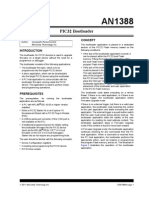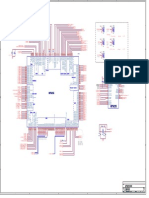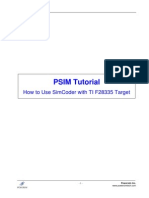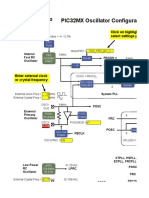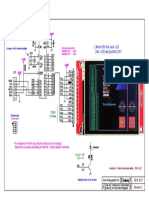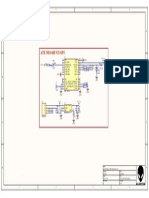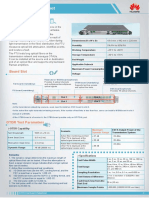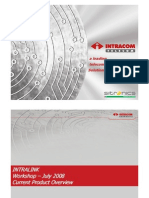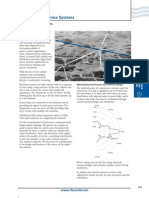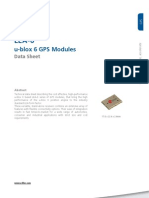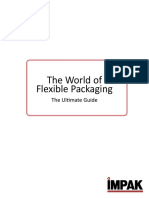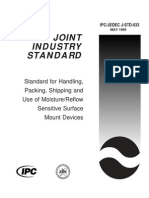Uart Gps Neo-6m (B) - Neo 6 Datasheet
Uart Gps Neo-6m (B) - Neo 6 Datasheet
Uploaded by
nion83Copyright:
Available Formats
Uart Gps Neo-6m (B) - Neo 6 Datasheet
Uart Gps Neo-6m (B) - Neo 6 Datasheet
Uploaded by
nion83Original Title
Copyright
Available Formats
Share this document
Did you find this document useful?
Is this content inappropriate?
Copyright:
Available Formats
Uart Gps Neo-6m (B) - Neo 6 Datasheet
Uart Gps Neo-6m (B) - Neo 6 Datasheet
Uploaded by
nion83Copyright:
Available Formats
locate, communicate, accelerate
NEO-6
u-blox 6 GPS Modules
Data Sheet
Abstract
Technical data sheet describing the cost effective, high-performance
u-blox 6 based NEO-6 series of GPS modules, that brings the high
performance of the u-blox 6 positioning engine to the miniature
NEO form factor.
These receivers combine a high level of integration capability with
flexible connectivity options in a small package. This makes them
perfectly suited for mass-market end products with strict size and
cost requirements.
www.u-blox.com
16.0 x 12.2 x 2.4mm
NEO-6 - Data Sheet
Document Information
Title
NEO-6
Subtitle
u-blox 6 GPS Modules
Document type
Data Sheet
Document number
GPS.G6-HW-09005-C
Document status
Preliminary
Document status information
Objective
This document contains target values. Revised and supplementary data will be published
Specification
later.
Advance
This document contains data based on early testing. Revised and supplementary data will
Information
be published later.
This document contains data from product verification. Revised and supplementary data
Preliminary
may be published later.
Released
This document contains the final product specification.
This document applies to the following products:
Name
Type number
ROM/FLASH version
PCN reference
NEO-6G
NEO-6Q
NEO-6M
NEO-6G-0-001
NEO-6Q-0-001
NEO-6M-0-001
ROM7.03
ROM7.03
ROM7.03
UBX-TM-11049
UBX-TM-11049
UBX-TM-11049
This document and the use of any information contained therein, is subject to the acceptance of the u-blox terms and conditions. They
can be downloaded from www.u-blox.com.
u-blox makes no warranties based on the accuracy or completeness of the contents of this document and reserves the right to make
changes to specifications and product descriptions at any time without notice. Reproduction, use or disclosure to third parties without
express permission is strictly prohibited. Copyright 2011, u-blox AG.
u-blox is a registered trademark of u-blox Holding AG in the EU and other countries. ARM is the registered trademark of ARM Limited in
the EU and other countries.
GPS.G6-HW-09005-C
Page 2 of 27
NEO-6 - Data Sheet
Contents
Contents.............................................................................................................................. 3
1
Functional description.................................................................................................. 5
1.1
Overview .............................................................................................................................................. 5
1.2
1.3
Product features ................................................................................................................................... 5
GPS performance.................................................................................................................................. 6
1.4
Block diagram....................................................................................................................................... 7
1.5
1.6
Assisted GPS (A-GPS) ............................................................................................................................ 7
AssistNow Autonomous .................................................................................................................... 7
1.7
Oscillators ............................................................................................................................................. 7
1.8
Protocols and interfaces ........................................................................................................................ 8
1.8.1
UART............................................................................................................................................. 8
1.8.2
USB ............................................................................................................................................... 8
1.8.3
1.8.4
Serial Peripheral Interface (SPI) ....................................................................................................... 8
Display Data Channel (DDC) .......................................................................................................... 8
1.9
Antenna ............................................................................................................................................... 9
1.10
Power Management ......................................................................................................................... 9
1.10.1 Maximum Performance Mode ....................................................................................................... 9
1.10.2
Eco Mode ...................................................................................................................................... 9
1.10.3 Power Save Mode ......................................................................................................................... 9
1.11
Configuration ................................................................................................................................... 9
1.11.1
1.12
Design-in ........................................................................................................................................ 10
Pin Definition .............................................................................................................. 11
2.1
Boot-time configuration ................................................................................................................ 9
Pin assignment ................................................................................................................................... 11
Electrical specifications .............................................................................................. 13
3.1
Absolute maximum ratings ................................................................................................................. 13
3.2
Operating conditions .......................................................................................................................... 14
3.3
3.4
Indicative power requirements ............................................................................................................ 15
SPI timing diagrams ............................................................................................................................ 16
3.4.1
Timing recommendations ............................................................................................................ 16
Mechanical specifications .......................................................................................... 17
Qualification and certification ................................................................................... 18
5.1
Reliability tests .................................................................................................................................... 18
5.2
Approvals ........................................................................................................................................... 19
Product handling & soldering .................................................................................... 19
6.1
Packaging ........................................................................................................................................... 19
GPS.G6-HW-09005-C
Preliminary
Page 3 of 27
NEO-6 - Data Sheet
6.1.1
6.1.2
6.2
Reels ........................................................................................................................................... 19
Tapes .......................................................................................................................................... 20
Shipment, storage and handling ......................................................................................................... 20
6.2.1
6.2.2
Moisture Sensitivity Levels ........................................................................................................... 20
Shipment..................................................................................................................................... 20
6.2.3
Storage and floor life ................................................................................................................... 22
6.2.4
6.2.5
Drying ......................................................................................................................................... 22
Reflow soldering ......................................................................................................................... 22
6.2.6
ESD handling precautions ............................................................................................................ 23
Default settings .......................................................................................................... 24
Labeling and ordering information........................................................................... 25
8.1
8.2
Product labeling.................................................................................................................................. 25
Explanation of codes........................................................................................................................... 25
8.3
Ordering information .......................................................................................................................... 25
Related documents........................................................................................................... 26
Revision history ................................................................................................................ 26
Contact .............................................................................................................................. 27
GPS.G6-HW-09005-C
Preliminary
Page 4 of 27
NEO-6 - Data Sheet
1 Functional description
1.1 Overview
The NEO-6 module series is a family of stand-alone GPS receivers featuring the high performance u-blox 6
positioning engine. These flexible and cost effective receivers offer numerous connectivity options in a miniature
16 x 12.2 x 2.4 mm package. Their compact architecture and power and memory options make NEO-6 modules
ideal for battery operated mobile devices with very strict cost and space constraints.
The 50-channel u-blox 6 positioning engine boasts a Time-To-First-Fix (TTFF) of under 1 second. The dedicated
acquisition engine, with 2 million correlators, is capable of massive parallel time/frequency space searches,
enabling it to find satellites instantly. Innovative design and technology suppresses jamming sources and
mitigates multipath effects, giving NEO-6 GPS receivers excellent navigation performance even in the most
challenging environments.
1.2 Product features
Table 1: Features of the NEO-6 Series
All NEO-6 modules are based on AEC-Q100 qualified GPS chips. See Chapter 5.1 for further information.
GPS.G6-HW-09005-C
Preliminary
Page 5 of 27
NEO-6 - Data Sheet
1.3 GPS performance
Parameter
Specification
Receiver type
50 Channels
GPS L1 frequency, C/A Code
SBAS: WAAS, EGNOS, MSAS
1
Time-To-First-Fix
Cold Start (Autonomous)
Warm Start (Autonomous)
Hot Start (Autonomous)
2
Aided Starts
3
27s
27s
1s
<3 s
NEO-6G/Q
NEO-6M
-162 dBm
-160 dBm
-148 dBm
-157 dBm
5Hz
-161 dBm
-160 dBm
-147 dBm
-156 dBm
Autonomous
SBAS
2.5 m
2.0 m
Maximum Navigation update rate
Configurable Timepulse frequency range
Velocity accuracy
Heading accuracy
Operational Limits
NEO-6M
26 s
26 s
1s
1s
Tracking & Navigation
Reacquisition4
Cold Start (Autonomous)
Hot Start
Sensitivity
Horizontal position accuracy5
NEO-6G/Q
0.1 Hz to 1 kHz
0.1m/s
0.5 degrees
Dynamics
4g
50,000 m
500 m/s
Altitude6
Velocity6
Table 2: NEO-6 GPS performance
1
2
3
4
5
6
All satellites at -130 dBm
Dependent on aiding data connection speed and latency
Demonstrated with a good active antenna
For an outage duration 10s
Under good GPS signal conditions
Assuming Airborne <4g platform
GPS.G6-HW-09005-C
Preliminary
Page 6 of 27
NEO-6 - Data Sheet
1.4 Block diagram
Figure 1: Block diagram (For available options refer to the product features table in section 1.2).
1.5 Assisted GPS (A-GPS)
Supply of aiding information like ephemeris, almanac, rough last position and time and satellite status and an
optional time synchronization signal will reduce time to first fix significantly and improve the acquisition
7
sensitivity. All NEO-6 modules support the u-blox AssistNow Online and AssistNow Offline A-GPS services and
are OMA SUPL compliant.
1.6 AssistNow Autonomous
AssistNow Autonomous provides functionality similar to Assisted-GPS without the need for a host or external
network connection. Based on previously broadcast satellite ephemeris data downloaded to and stored by the
GPS receiver, AssistNow Autonomous automatically generates accurate satellite orbital data (AssistNow
Autonomous data) that is usable for future GPS position fixes. AssistNow Autonomous data is reliable for up to
3 days after initial capture.
u-blox AssistNow Autonomous benefits are:
Faster position fix
No connectivity required
Complementary with AssistNow Online and Offline services
No integration effort, calculations are done in the background
For more details see the u-blox 6 Receiver Description including Protocol Specification [2].
1.7 Oscillators
NEO-6 GPS modules are available in Crystal and TCXO versions. The TCXO allows accelerated weak signal
acquisition, enabling faster start and reacquisition times.
Requires external memory.
GPS.G6-HW-09005-C
Preliminary
Page 7 of 27
NEO-6 - Data Sheet
1.8 Protocols and interfaces
Protocol
Type
NMEA
Input/output, ASCII, 0183, 2.3 (compatible to 3.0)
UBX
RTCM
Input/output, binary, u-blox proprietary
Input, 2.3
Table 3: Available protocols
Both protocols are available on UART, USB, and DDC. For specification of the various protocols see the u-blox 6
Receiver Description including Protocol Specification [2].
NEO-6 modules support a number of peripheral interfaces for serial communication. The embedded firmware
uses these interfaces according to their respective protocol specifications. For specific applications, the firmware
also supports the connection of external memories.
1.8.1 UART
NEO-6 modules include one configurable UART interface for serial communication (for information about
configuration see section 1.10).
1.8.2 USB
NEO-6 modules provide a USB version 2.0 FS (Full Speed, 12Mbit/s) interface as an alternative to the UART. The
pull-up resistor on USB_DP is integrated to signal a full-speed device to the host. The VDDUSB pin supplies the
USB interface.
u-blox provides a Microsoft certified USB driver for Windows XP, Windows Vista and Windows 7 operating
systems.
Operating System
Support level
Windows XP
Windows Vista
Certified
Certified
Windows 7
Certified
Table 4: Operating systems supported by USB driver
1.8.3 Serial Peripheral Interface (SPI)
The SPI interface allows for the connection of external devices with a serial interface, e.g. serial flash to save
configuration and AssistNow Offline A-GPS data or to interface to a host CPU. The interface can be operated in
master or slave mode. In master mode, one chip select signal is available to select external slaves. In slave mode a
single chip select signal enables communication with the host.
The maximum bandwidth is 100kbit/s.
1.8.4 Display Data Channel (DDC)
2
The I C compatible DDC interface can be used either to access external devices with a serial interface EEPROM or
2
to interface with a host CPU. It is capable of master and slave operation. The DDC interface is I C Standard Mode
2
compliant. For timing parameters consult the I C standard.
The DDC Interface is compatible with LEON DDC from version LEON-G100-05S/ LEON-G200-05S and above.
The maximum bandwidth is 100kbit/s.
1.8.4.1 External serial EEPROM
NEO-6 modules allow an optional external serial EEPROM to be connected to the DDC interface. This can be
used to store Configurations permanently.
For more information see the LEA-6/NEO-6/MAX-6 Hardware Integration Manual [1].
GPS.G6-HW-09005-C
Preliminary
Page 8 of 27
NEO-6 - Data Sheet
1.9 Antenna
8
NEO-6 modules are designed for use with passive and active antennas.
Parameter
Specification
Antenna Type
Active Antenna Recommendations
Passive and active antenna
Minimum gain
Maximum gain
Maximum noise figure
15 dB (to compensate signal loss in RF cable)
50 dB
1.5 dB
Table 5: Antenna Specifications for all NEO-6 modules
1.10 Power Management
u-blox receivers support different power modes. These modes represent strategies of how to control the
acquisition and tracking engines in order to achieve either the best possible performance or good performance
with reduced power consumption.
For more information about power management strategies, see the u-blox 6 Receiver Description
including Protocol Specification [2].
1.10.1 Maximum Performance Mode
During a Cold start, a receiver in Maximum Performance Mode continuously deploys the acquisition engine to
search for all satellites. Once the receiver has a position fix (or if pre-positioning information is available), the
acquisition engine continues to be used to search for all visible satellites that are not being tracked.
1.10.2 Eco Mode
During a Cold start, a receiver in Eco Mode works exactly as in Maximum Performance Mode. Once a position
can be calculated and a sufficient number of satellites are being tracked, the acquisition engine is powered off
resulting in significant power savings. The tracking engine continuously tracks acquired satellites and acquires
other available or emerging satellites.
Note that even if the acquisition engine is powered off, satellites continue to be acquired.
1.10.3 Power Save Mode
Power Save Mode (PSM) allows a reduction in system power consumption by selectively switching parts of the
receiver on and off.
1.11 Configuration
1.11.1 Boot-time configuration
NEO-6 modules provide configuration pins for boot-time configuration. These become effective immediately
after start-up. Once the module has started, the configuration settings can be modified with UBX configuration
messages. The modified settings remain effective until power-down or reset. If these settings have been stored
in battery-backup RAM, then the modified configuration will be retained, as long as the backup battery supply is
not interrupted.
For information on using active antennas with NEO-6 modules, see the LEA-6/NEO-6 Hardware Integration Manual [1].
GPS.G6-HW-09005-C
Preliminary
Page 9 of 27
NEO-6 - Data Sheet
NEO-6 modules include both CFG_COM0 and CFG_COM1 pins and can be configured as seen in Table 6.
Default settings in bold.
CFG_COM1
CFG_COM0
Protocol
Messages
UARTBaud rate
USB power
1
1
1
0
NMEA
NMEA
GSV, RMC, GSA, GGA, GLL, VTG, TXT
GSV, RMC, GSA, GGA, GLL, VTG, TXT
9600
38400
BUS Powered
Self Powered
0
0
1
0
NMEA
UBX
GSV9, RMC, GSA, GGA, VTG, TXT
NAV-SOL, NAV-STATUS, NAV-SVINFO, NAV-CLOCK,
INF, MON-EXCEPT, AID-ALPSERV
4800
57600
BUS Powered
BUS Powered
Table 6: Supported COM settings
NEO-6 modules include a CFG_GPS0 pin, which enables the boot-time configuration of the power mode. These
settings are described in Table 7. Default settings in bold.
CFG_GPS0
Power Mode
Eco Mode
Maximum Performance Mode
Table 7: Supported CFG_GPS0 settings
Static activation of the CFG_COM and CFG_GPS pins is not compatible with use of the SPI interface.
1.12 Design-in
In order to obtain the necessary information to conduct a proper design-in, u-blox strongly recommends
consulting the LEA-6/NEO-6/MAX-6 Hardware Integration Manual [1].
Every 5th fix.
GPS.G6-HW-09005-C
Preliminary
Page 10 of 27
NEO-6 - Data Sheet
2 Pin Definition
2.1 Pin assignment
13
12
14
11
15
10
16
17
NEO-6
18
Top View
19
7
6
20
21
22
23
24
Figure 2 Pin Assignment
No
Module
Name
I/O
Description
All
Reserved
Reserved
All
SS_N
SPI Slave Select
All
TIMEPULSE
Time pulse (1PPS)
4
5
All
All
EXTINT0
USB_DM
I
I/O
External Interrupt Pin
USB Data
6
7
All
All
USB_DP
VDDUSB
I/O
I
USB Data
USB Supply
All
Reserved
All
VCC_RF
10
All
GND
Output Voltage RF section
Pin 8 and 9 must be connected together.
Ground
11
All
RF_IN
GPS signal input
12
All
GND
Ground
13
All
GND
14
All
MOSI/CFG_COM0
O/I
15
All
MISO/CFG_COM1
16
All
CFG_GPS0/SCK
17
All
Reserved
Ground
SPI MOSI / Configuration Pin.
Leave open if not used.
SPI MISO / Configuration Pin.
Leave open if not used.
Power Mode Configuration Pin / SPI Clock.
Leave open if not used.
Reserved
18
All
SDA2
I/O
DDC Data
19
20
All
All
SCL2
TxD1
I/O
O
DDC Clock
Serial Port 1
21
All
RxD1
Serial Port 1
GPS.G6-HW-09005-C
Preliminary
See Hardware Integration Manual
Pin 8 and 9 must be connected together.
Page 11 of 27
NEO-6 - Data Sheet
No
Module
Name
I/O
Description
22
All
V_BCKP
Backup voltage supply
23
All
VCC
Supply voltage
24
All
GND
Ground
Table 8: Pinout
Pins designated Reserved should not be used. For more information about Pinouts see the LEA-6/NEO6/MAX-6 Hardware Integration Manual [1].
GPS.G6-HW-09005-C
Preliminary
Page 12 of 27
NEO-6 - Data Sheet
3 Electrical specifications
3.1 Absolute maximum ratings
Parameter
Symbol
Module
Min
Max
Units
Power supply voltage
VCC
NEO-6G
Condition
-0.5
2.0
-0.5
3.6
Backup battery voltage
V_BCKP
NEO-6Q/
NEO-6M
All
-0.5
3.6
USB supply voltage
Input pin voltage
VDDUSB
Vin
All
All
-0.5
-0.5
3.6
3.6
V
V
Vin_usb
Ipin
All
-0.5
DC current trough any digital I/O pin (except supplies)
VDDUSB
10
V
mA
VCC_RF output current
Input power at RF_IN
ICC_RF
Prfin
All
All
100
15
mA
dBm
Storage temperature
Tstg
All
85
source impedance
= 50 ,
continuous wave
-40
Table 9: Absolute maximum ratings
GPS receivers are Electrostatic Sensitive Devices (ESD) and require special precautions when
handling. For more information see chapter 6.2.6.
Stressing the device beyond the Absolute Maximum Ratings may cause permanent damage.
These are stress ratings only. The product is not protected against overvoltage or reversed
voltages. If necessary, voltage spikes exceeding the power supply voltage specification, given in
table above, must be limited to values within the specified boundaries by using appropriate
protection diodes. For more information see the LEA-6/ NEO-6/ MAX-6 Hardware Integration
Manual [1].
GPS.G6-HW-09005-C
Preliminary
Page 13 of 27
NEO-6 - Data Sheet
3.2 Operating conditions
All specifications are at an ambient temperature of 25C.
Parameter
Symbol
Module
Min
Typ
Max
Power supply voltage
VCC
1.75
2.7
1.8
3.0
1.95
3.6
Supply voltage USB
VDDUSB
NEO-6G
NEO-6Q,
NEO-6M
All
Unit
s
V
V
3.0
3.3
3.6
Backup battery voltage
V_BCKP
All
1.4
3.6
Backup battery current
I_BCKP
All
Input pin voltage range
Digital IO Pin Low level input voltage
Vin
Vil
All
All
0
0
VCC
0.2*VCC
V
V
Digital IO Pin High level input voltage
Vih
All
0.7*VCC
VCC
Digital IO Pin Low level output voltage
Digital IO Pin High level output voltage
Vol
Voh
All
All
0.4
VCC -0.4
V
V
USB_DM, USB_DP
VCC_RF voltage
VinU
VCC_RF
All
All
Compatible with USB with 22 Ohms series resistance
VCC-0.1
V
VCC_RF output current
Antenna gain
ICC_RF
Gant
All
All
Receiver Chain Noise Figure
Operating temperature
NFtot
Topr
All
All
22
50
50
mA
dB
85
dB
C
3.0
-40
Condition
V_BCKP = 1.8 V,
VCC = 0V
Iol=4mA
Ioh=4mA
Table 10: Operating conditions
Operation beyond the specified operating conditions can affect device reliability.
GPS.G6-HW-09005-C
Preliminary
Page 14 of 27
NEO-6 - Data Sheet
3.3 Indicative power requirements
Table 11 lists examples of the total system supply current for a possible application.
Parameter
Symbol
Module
Max. supply current 10
Iccp
All
Icc Acquisition
All
NEO-6G/Q
4714
4015
mA
mA
Icc Tracking
NEO-6M
NEO-6G/Q
3915
3815
mA
mA
(Eco mode)
NEO-6M
3715
mA
Icc Tracking
NEO-6G/Q
NEO-6M
1215
1115
mA
mA
Icc Tracking
(Max Performance mode)
Average supply current
13
(Power Save mode / 1 Hz)
Min
Typ
Max
Units
Condition
67
mA
VCC = 3.6 V11 /
1.95 V12
VCC = 3.0 V11 /
1.8 V12
Table 11: Indicative power requirements
Values in Table 11 are provided for customer information only as an example of typical power
requirements. Values are characterized on samples, actual power requirements can vary depending on
FW version used, external circuitry, number of SVs tracked, signal strength, type of start as well as time,
duration and conditions of test.
10
Use this figure to dimension maximum current capability of power supply. Measurement of this parameter with 1 Hz bandwidth.
NEO-6Q, NEO-6M
12
NEO-6G
13
Use this figure to determine required battery capacity.
14
>8 SVs in view, CNo >40 dBHz, current average of 30 sec after cold start.
15
With strong signals, all orbits available. For Cold Starts typical 12 min after first fix. For Hot Starts typical 15 s after first fix.
11
GPS.G6-HW-09005-C
Preliminary
Page 15 of 27
NEO-6 - Data Sheet
3.4 SPI timing diagrams
In order to avoid a faulty usage of the SPI, the user needs to comply with certain timing conditions. The
following signals need to be considered for timing constraints:
Symbol
Description
SS_N
Slave Select signal
SCK
Slave Clock signal
Table 12: Symbol description
Figure 3: SPI timing diagram
3.4.1 Timing recommendations
The recommendations below are based on a firmware running from Flash memory.
Parameter
Description
Recommendation
tINIT
Initialization Time
500 s
tDES
Bitrate
Deselect Time
1 ms
100 kbit/s
Table 13: SPI timing recommendations
The values in the above table result from the requirement of an error-free transmission. By allowing just
a few errors, the byte rate could be increased considerably. These timings and therefore the byte rate
could also be improved by disabling other interfaces, e.g. the UART.
16
The maximum bandwidth is 100 kbit/s .
16
This is a theoretical maximum, the protocol overhead is not considered.
GPS.G6-HW-09005-C
Preliminary
Page 16 of 27
NEO-6 - Data Sheet
4 Mechanical specifications
Figure 4: Dimensions
For information regarding the Paste Mask and Footprint see the LEA-6/NEO-6/MAX-6 Hardware
Integration Manual [1].
GPS.G6-HW-09005-C
Preliminary
Page 17 of 27
NEO-6 - Data Sheet
5 Qualification and certification
5.1 Reliability tests
All NEO-6 modules are based on AEC-Q100 qualified GPS chips.
Tests for product family qualifications according to ISO 16750 "Road vehicles - Environmental conditions and
testing for electrical and electronic equipment, and appropriate standards (see Table 14).
Test
Reference
Test Conditions
Temperature step
test
ISO16750-4
IEC60068-2-1
IEC60068-2-2
IEC60068-2-14 Na
Function tests at stable temperature. The temperature has to decrease in 5K steps
from RT to -40C followed by increase to +85C in 5K steps.
Dry heat I
("desert")
IEC60068-2-2
+60C / 5%rH,Toper max, VCCmax, 1000 hours, in function
Damp heat II
("tropical")
IEC60068-2-3
+60C/95%rH, Toper max, VCCmax, 1000 hours, in function
High
Temp.Operating
Life (Life span)
Dry heat II
IEC60068-2-2
1000hrs @ 85C Ta
Toper max, VCCmax
IEC60068-2-2
+125C, 1000 hours, no function
Function test at
Umin, Unom,
Umax
ISO16750-4
IEC60068-2-1
IEC60068-2-2
IEC60068-2-30 Db Variation 1
Function test at Umin, Unom, Umax
1 hour / voltage level
Test at -40C, RT, +85C
+25C...+55C; >90% rH
6 cycles of 24 hours
Vibration in
function
IEC60068-2-6
Mechanical Shock
IEC60068-2-27 Ea
5-500 Hz; 5g;
2.5 hrs/axis at 40C
2.5 hrs/axis at +85C
3 hrs/axis at RT
Total: 24 hours, function supervision
30g/11ms (halfsine), 3 Shocks/axis, no function
Robustness of
terminations of
Surface Mounted
Devices
IEC60068-2-21 Ue1
ESD (HBM)
JESD22-A114
AEC-Q100-002
ESD (MM)
JESD22-A115
AEC-Q100-003
Temperature
cycling
Damp heat cyclic
-40C / +125C, 300 cycles, air to air
No function
1mm/s +/- 0.5mm/s
D>2mm
1 Bending cycle
Duration on Dmax: 20s +/- 1s
Voltage level: 2000V
Voltage level: 200V
Table 14: u-blox qualification requirements
GPS.G6-HW-09005-C
Preliminary
Page 18 of 27
NEO-6 - Data Sheet
5.2 Approvals
Products marked with this lead-free symbol on the product label comply with the
"Directive 2002/95/EC of the European Parliament and the Council on the Restriction of
Use of certain Hazardous Substances in Electrical and Electronic Equipment" (RoHS).
All u-blox 6 GPS modules are RoHS compliant.
6 Product handling & soldering
6.1 Packaging
NEO-6 modules are delivered as hermetically sealed, reeled tapes in order to enable efficient production,
production lot set-up and tear-down.
Figure 5: Reeled u-blox 6 modules
6.1.1 Reels
NEO-6 GPS modules are deliverable in quantities of 250pcs on a reel. The dimensions of the reel are shown in
Figure 6.
Figure 6: Dimension of reel for 250 pieces (dimensions unless otherwise specified in mm)
GPS.G6-HW-09005-C
Preliminary
Page 19 of 27
NEO-6 - Data Sheet
6.1.2 Tapes
The dimensions and orientations of the tapes for NEO-6 modules are specified in Figure 7.
Figure 7: Dimensions and orientation for NEO-6 modules on tape
6.2 Shipment, storage and handling
NEO modules are designed and packaged to be processed in an automatic assembly line, and are shipped in
Tape-and-Reel.
NEO-6 modules are Moisture Sensitive Devices (MSD) in accordance to the IPC/JEDEC
specification. Appropriate MSD handling instructions and precautions are summarized in
Sections 6.2.1 to 6.2.3. Read them carefully to prevent permanent damage due to moisture
intake.
GPS receivers contain highly sensitive electronic circuitry and are Electrostatic Sensitive Devices
(ESD). Handling NEO-6 modules without proper ESD protection may destroy or damage them
permanently. See Section 6.2.6 for ESD handling instructions.
6.2.1 Moisture Sensitivity Levels
The Moisture Sensitivity Level (MSL) relates to the packaging and handling precautions required. NEO-6 modules
are rated at MSL level 4.
For MSL standard see IPC/JEDEC J-STD-020, which can be downloaded from www.jedec.org.
6.2.2 Shipment
Table 15 summarizes the dry pack requirements for different MSL levels in the IPC/JDEC specification.
MSL Level
Dry Pack Requirement
Optional
Required
Required
Required
Required
2
2a
3
4
Table 15: JEDEC specification of dry pack requirements
GPS.G6-HW-09005-C
Preliminary
Page 20 of 27
NEO-6 - Data Sheet
According to IPC/JEDEC specification J-STD-020, if a device passes MSL level 1, it is classified as not moisture
sensitive and does not require dry pack. If a device fails level 1 but passes a higher numerical level, it is classified
as moisture sensitive and must be dry packed in accordance with J-STD-033.
NEO-6 modules are delivered on Tape-and-Reels in a hermetically sealed package ("dry bag") to prevent
moisture intake and protect against electrostatic discharge. For protection from physical damage, the reels are
individually packed in cartons.
Carrier materials such as trays, tubes, reels, etc., that are placed in the Moisture Barrier Bag (MBB) can affect the
moisture level within the MBB. Therefore, the effect of these materials is compensated by adding additional
desiccant in the MBB to ensure the shelf life of the SMD packages.
The dry bag provides an IPC/JEDEC compliant MSD label describing the handling requirements to prevent
humidity intake. IPC/JEDEC specifications require that MSD sensitive devices be packaged together with a
Humidity Indicator Card (HIC) and desiccant to absorb humidity. If no moisture has been absorbed, the three
fields in the HIC indicate blue color. Figure 8 shows examples of an MSD label and HIC.
72
01.01.2009
Figure 8: Examples of MSD label and Humidity Indicator Card
GPS.G6-HW-09005-C
Preliminary
Page 21 of 27
NEO-6 - Data Sheet
6.2.3 Storage and floor life
The calculated shelf life for dry packed SMD packages is a minimum of 12 months from the bag seal date, when
stored in a noncondensing atmospheric environment of <40C/90% RH.
Table 16 lists floor life for different MSL levels in the IPC/JEDEC specification.
MSL level
Floor life (out of bag) at factory ambient 30C/60% RH or as stated
Unlimited at 30C/85% RH
1 year
4 weeks
168 hours
72 hours
2
2a
3
4
Table 16: JEDEC specification of floor life
The parts must be processed and soldered within the time specified for the MSL level. If this time is exceeded, or
the humidity indicator card in the sealed package indicates that they have been exposed to moisture, the devices
need to be pre-baked before the reflow solder process.
6.2.4 Drying
Both encapsulant and substrate materials absorb moisture. IPC/JEDEC specification J-STD-020 must be observed
to prevent cracking and delamination associated with the "popcorn" effect during reflow soldering. The
popcorn effect can be described as miniature explosions of evaporating moisture. Baking before processing is
required in the following cases:
Humidity indicator card: At least one circular indicator is no longer blue
Floor life or environmental requirements after opening the seal have been exceeded, e.g. exposure to
excessive seasonal humidity.
Refer to Section 4 of IPC/JEDEC J-STD-033 for recommended baking procedures. Table 4-1 of the specification
lists the required bake times and conditions for drying. For example, a module that has exceeded its floor life by
>72 hours shall be baked at 125C for 48 hours. (Floor life begins counting at time = 0 after bake).
Do not attempt to bake NEO modules while contained in tape and rolled up in reels. For baking,
place parts individually onto oven tray.
Oxidation Risk: Baking SMD packages may cause oxidation and/or intermetallic growth of the
terminations, which if excessive can result in solderability problems during board assembly. The
temperature and time for baking SMD packages are therefore limited by solderability
considerations. The cumulative bake time at a temperature greater than 90C and up to 125C
shall not exceed 96 hours. If the bake temperature is not greater than 90C, there is no limit on
bake time. Bake temperatures higher than 125C are not allowed.
6.2.5 Reflow soldering
Reflow profiles are to be selected according u-blox recommendations (see LEA-6/NEO-6/MAX-6 Hardware
Integration Manual [1]).
GPS.G6-HW-09005-C
Preliminary
Page 22 of 27
NEO-6 - Data Sheet
6.2.6 ESD handling precautions
NEO-6 modules are Electrostatic Sensitive Devices (ESD). Observe precautions
for handling! Failure to observe these precautions can result in severe damage
to the GPS receiver!
GPS receivers are Electrostatic Sensitive Devices (ESD) and require special precautions when handling. Particular
care must be exercised when handling patch antennas, due to the risk of electrostatic charges. In addition to
standard ESD safety practices, the following measures should be taken into account whenever handling the
receiver:
Unless there is a galvanic coupling between the local GND (i.e. the
work table) and the PCB GND, then the first point of contact when
handling the PCB shall always be between the local GND and PCB
GND.
GND
Local GND
Before mounting an antenna patch, connect ground of the device
When handling the RF pin, do not come into contact with any
charged capacitors and be careful when contacting materials that
can develop charges (e.g. patch antenna ~10pF, coax cable ~5080pF/m, soldering iron, )
RF_IN
ESD
Sensitive!
To prevent electrostatic discharge through the RF input, do not
touch any exposed antenna area. If there is any risk that such
exposed antenna area is touched in non ESD protected work area,
implement proper ESD protection measures in the design.
When soldering RF connectors and patch antennas to the receivers
RF pin, make sure to use an ESD safe soldering iron (tip).
RF_IN
ESD Safe
GPS.G6-HW-09005-C
Preliminary
Page 23 of 27
NEO-6 - Data Sheet
7 Default settings
Interface
Settings
Serial Port 1 Output
9600 Baud, 8 bits, no parity bit, 1 stop bit
Configured to transmit both NMEA and UBX protocols, but only following NMEA and no
UBX messages have been activated at start-up:
GGA, GLL, GSA, GSV, RMC, VTG, TXT
USB Output
Configured to transmit both NMEA and UBX protocols, but only following NMEA and no
UBX messages have been activated at start-up:
GGA, GLL, GSA, GSV, RMC, VTG, TXT
USB Power Mode: Bus-Powered
9600 Baud, 8 bits, no parity bit, 1 stop bit
Automatically accepts following protocols without need of explicit configuration:
UBX, NMEA
The GPS receiver supports interleaved UBX and NMEA messages.
Automatically accepts following protocols without need of explicit configuration:
UBX, NMEA
The GPS receiver supports interleaved UBX and NMEA messages.
USB Power Mode: Bus-Powered
Serial Port 1 Input
USB Input
TIMEPULSE
(1Hz Nav)
Power Mode
1 pulse per second, synchronized at rising edge, pulse length 100ms
Maximum Performance mode
Table 17: Available protocols
Refer to the LEA-6/NEO-6/MAX-6 Hardware Integration Manual [1] for information about further settings.
GPS.G6-HW-09005-C
Preliminary
Page 24 of 27
NEO-6 - Data Sheet
8 Labeling and ordering information
8.1 Product labeling
The labeling of u-blox 6 GPS modules includes important product information. The location of the product type
number is shown in Figure 9.
Product type number
PPP-GV-T-XXX
Figure 9: Location of product type number on u-blox 6 module label
8.2 Explanation of codes
3 different product code formats are used. The Product Name is used in documentation such as this data sheet
and identifies all u-blox 6 products, independent of packaging and quality grade. The Ordering Code includes
options and quality, while the Type Number includes the hardware and firmware versions. Table 18 below
details these 3 different formats:
Format
Structure
Product Name
PPP-GV
Ordering Code
Type Number
PPP-GV-T
PPP-GV-T-XXX
Table 18: Product Code Formats
The parts of the product code are explained in Table 19.
Code
Meaning
Example
PPP
G
Product Family
Product Generation
NEO
6 = u-blox6
V
T
Variant
Option / Quality Grade
XXX
Product Detail
T = Timing, R = DR, etc.
Describes standardized functional element or quality grade such as
Flash size, automotive grade etc.
Describes product details or options such as hard- and software
revision, cable length, etc.
Table 19: part identification code
8.3 Ordering information
Ordering No.
Product
NEO-6G-0
NEO-6M-0
ROM-based u-blox 6 GPS Module with TCXO 1.8V, 12x16mm, 250 pcs/reel
ROM-based u-blox 6 GPS Module, 12x16mm, 250 pcs/reel
NEO-6Q-0
ROM-based u-blox 6 GPS Module with TCXO, 12x16mm, 250 pcs/reel
Table 20: Product Ordering Codes
GPS.G6-HW-09005-C
Preliminary
Page 25 of 27
NEO-6 - Data Sheet
Product changes affecting form, fit or function are documented by u-blox. For a list of Product Change
Notifications (PCNs) see our website at: http://www.u-blox.com/en/notifications.html
Related documents
[1]
LEA-6/NEO-6/MAX-6 Hardware Integration Manual, Docu. GPS.G6-HW-09007
[2]
u-blox 6 Receiver Description including Protocol Specification, Docu. No GPS-SW-09017
All these documents are available on our homepage (http://www.u-blox.com).
For regular updates to u-blox documentation and to receive product change notifications please register
on our homepage.
Revision history
Revision
Date
Name
Status / Comments
31/08/2009
tgri
Initial Version
21/09/2009
tgri
25/02/2010
tgri
update of section 1.3 GPS performance, section 1.4 block diagram,
section 3.2 peak supply current
Change of status to Advance Information. Addition of NEO-6G.
Update of section 1.8.2, removed reference to Vddio added USB
driver certification. Update of section 3.2 table 11: average supply
current, Added section 3.3-3.4: SPI & DDC timing, section 5.1:
addition of table 12.
24/06/2010
dhur
Change of status to Preliminary. Update of section 1.2, 1.8.4, 1.10.4,
3.1, 3.2 and chapter 2 and 4. General clean-up and consistency
check.
B1
C
11/08/2010
18/07/2011
dhur
dhur
Replaced graphic in figure 2.
Added chapter 1.6, update to FW7.03.
GPS.G6-HW-09005-C
Preliminary
Page 26 of 27
NEO-6 - Data Sheet
Contact
For complete contact information visit us at www.u-blox.com
Headquarters
u-blox AG
Zuercherstrasse 68
CH-8800 Thalwil
Switzerland
Phone:
+41 44 722 74 44
Fax:
+41 44 722 74 47
E-mail:
info@u-blox.com
Offices
North, Central and South America
Europe, Middle East, Africa
Asia, Australia, Pacific
u-blox America, Inc.
Phone:
+1 (703) 483 3180
E-mail:
info_us@u-blox.com
u-blox AG
Phone:
+41 44 722 74 44
E-mail:
info@u-blox.com
Regional Office West Coast:
Phone:
+1 (703) 483 3184
E-mail:
info_us@u-blox.com
Technical Support:
Phone:
+41 44 722 74 44
E-mail:
info@u-blox.com
u-blox Singapore Pte. Ltd.
Phone:
+65 6734 3811
E-mail:
info_ap@u-blox.com
Support: support_ap@u-blox.com
Technical Support:
Phone:
E-mail:
+1 (703) 483 3185
support_us@u-blox.com
Regional Office China:
Phone:
+86 10 68 133 545
E-mail:
info_cn@u-blox.com
Support: support_cn@u-blox.com
Regional Office Japan:
Phone:
+81 3 5775 3850
E-mail:
info_jp@u-blox.com
Support: support_jp@u-blox.com
Regional Office Korea:
Phone:
+82 2 542 0861
E-mail:
info_kr@u-blox.com
Support: support_kr@u-blox.com
Regional Office Taiwan:
Phone:
+886 2 2657 1090
E-mail:
info_tw@u-blox.com
Support: support_tw@u-blox.com
GPS.G6-HW-09005-C
Preliminary
Page 27 of 27
You might also like
- Philips 715g5821 m01 000 004i Meridian 5 Chassis SCHDocument8 pagesPhilips 715g5821 m01 000 004i Meridian 5 Chassis SCHRamkiNo ratings yet
- RL 1Document62 pagesRL 1MuazamFakhriSunyNo ratings yet
- Humidity Indicator Card How To ReadDocument10 pagesHumidity Indicator Card How To ReadSneha PatelNo ratings yet
- Iot Based System For Heart Rate Monitoring IJERTV9IS070673Document9 pagesIot Based System For Heart Rate Monitoring IJERTV9IS070673Penrose LearningNo ratings yet
- MT6592 Mediatek PDFDocument53 pagesMT6592 Mediatek PDFpop678100% (1)
- Dev Kit 8000Document5 pagesDev Kit 8000Shiva prasadNo ratings yet
- MediaTek LinkIt Smart 7688 Duo Pin Out v1 3Document1 pageMediaTek LinkIt Smart 7688 Duo Pin Out v1 3teguhscribdNo ratings yet
- KQ330Document20 pagesKQ330Darlin LizcanoNo ratings yet
- Dspic DevDocument9 pagesDspic Devlibrian_30005821No ratings yet
- Schéma Kit-PIC16F877Document1 pageSchéma Kit-PIC16F877Romaric Tankoano100% (1)
- ESP8266 - Independent Study - mr945 PDFDocument49 pagesESP8266 - Independent Study - mr945 PDFsaravananNo ratings yet
- SPD39T 39B6X Service Manual-01-0226 PDFDocument63 pagesSPD39T 39B6X Service Manual-01-0226 PDFAlejandroVCMXNo ratings yet
- Hynix Part NumberDocument1 pageHynix Part NumberkikitoriNo ratings yet
- Open Compute Project Intel Motherboard v2.0 YGMDocument32 pagesOpen Compute Project Intel Motherboard v2.0 YGMgawinNo ratings yet
- Cisco Unified CME and Cisco IOS Software Version Compatibility Matrix - CiscoDocument2 pagesCisco Unified CME and Cisco IOS Software Version Compatibility Matrix - Ciscoarada1729No ratings yet
- SDM439 GPIO Configuration For QRD439+PMI632Document33 pagesSDM439 GPIO Configuration For QRD439+PMI632Jhonny B. S SarmientoNo ratings yet
- An1388 Pic32 BootloaderDocument16 pagesAn1388 Pic32 Bootloadercroud_freak100% (1)
- Uart Gps Neo-7m-C (B) - SchematicDocument1 pageUart Gps Neo-7m-C (B) - Schematicnion8350% (2)
- Step by Step - Install - Moshell NewDocument6 pagesStep by Step - Install - Moshell NewAnnie Da-BathNo ratings yet
- Interfacing P10 LED Display With ArduinoDocument8 pagesInterfacing P10 LED Display With ArduinoRaju D PuthusserryNo ratings yet
- IBHNet Manual PDFDocument50 pagesIBHNet Manual PDFJosito HNNo ratings yet
- 89s52 Microcontroller TutorialDocument30 pages89s52 Microcontroller Tutorialm_adavoodi6479No ratings yet
- BASCOM - Programming of Microcontrollers With EaseDocument236 pagesBASCOM - Programming of Microcontrollers With EasesaledjordjevicNo ratings yet
- Mediatek MT6235Document9 pagesMediatek MT6235rockstar5kNo ratings yet
- Tutorial - SimCoder With TI F28335 TargetDocument12 pagesTutorial - SimCoder With TI F28335 TargetjebasinghjsNo ratings yet
- Node-RedDocument25 pagesNode-RedAhmad SolihinNo ratings yet
- Java Socket Programming ManualDocument28 pagesJava Socket Programming ManualPrasad Borole100% (1)
- Dell E177FPc Service Manual PDFDocument161 pagesDell E177FPc Service Manual PDFBoata Eta100% (1)
- MediaTek LinkIt Smart 7688 Pin Out v1 3Document1 pageMediaTek LinkIt Smart 7688 Pin Out v1 3Eligio VásquezNo ratings yet
- Topic 2 Contextual Reference: Faisal Adnil Pamungkas 201311011 / 1A-TEL B. InggrisDocument3 pagesTopic 2 Contextual Reference: Faisal Adnil Pamungkas 201311011 / 1A-TEL B. Inggris1B-TKIIdham Kholid IbrahimNo ratings yet
- Pic32 Osc Config v1.1Document45 pagesPic32 Osc Config v1.1harikrishna242424No ratings yet
- mt6261d MediatekDocument85 pagesmt6261d Mediatekapi-432313169No ratings yet
- A 28Nm Poly/Sion Cmos Technology For Low-Power Soc ApplicationsDocument2 pagesA 28Nm Poly/Sion Cmos Technology For Low-Power Soc ApplicationsOne TzueNo ratings yet
- ASUS X51C (T12C) Schematic Diagrams PDFDocument94 pagesASUS X51C (T12C) Schematic Diagrams PDFNelson AlookarenNo ratings yet
- Sim7230 Hardware Design v1.02 PDFDocument46 pagesSim7230 Hardware Design v1.02 PDFCristian BandilaNo ratings yet
- 8051 InterfacingDocument32 pages8051 InterfacingSrikar Namburu100% (1)
- Memory Validation List ExternalDocument135 pagesMemory Validation List ExternalVlad CasuneanuNo ratings yet
- Nodemcu: An Open Source IOT PlatformDocument13 pagesNodemcu: An Open Source IOT PlatformHasnain Kashif100% (1)
- Controller DatasheetDocument7 pagesController DatasheetJoshuaa1b2c3No ratings yet
- LVDS Connector 30 PIN CompositeDocument2 pagesLVDS Connector 30 PIN CompositebingolahNo ratings yet
- How To Use secureCRT Startup Log FileDocument17 pagesHow To Use secureCRT Startup Log FileMecael DesuyoNo ratings yet
- dsPIC Microcontroller PDFDocument19 pagesdsPIC Microcontroller PDFSỹ RonNo ratings yet
- 8100 Mobile Device Test System: Configuration Guide For The E5515C (Agilent 8960) Test SetDocument16 pages8100 Mobile Device Test System: Configuration Guide For The E5515C (Agilent 8960) Test SetIvan GomezNo ratings yet
- ILI9341 2R8 240x320 Cir ENDocument1 pageILI9341 2R8 240x320 Cir ENBeenish MirzaNo ratings yet
- SIMATIC Box PC 627.Document200 pagesSIMATIC Box PC 627.jacastillo68No ratings yet
- Proteus TutorialDocument5 pagesProteus TutorialAlfred GaleaNo ratings yet
- GPS Neo-6m-V12 SCHDocument1 pageGPS Neo-6m-V12 SCHKwok Chung Chu100% (1)
- ZiLOG Z8 Series Sample ProjectsDocument3 pagesZiLOG Z8 Series Sample Projectstechyboy22No ratings yet
- d9b19 Compal JBL00 LA-3801P - DeLL E6400 Laptop SchematicsDocument66 pagesd9b19 Compal JBL00 LA-3801P - DeLL E6400 Laptop SchematicsAdi Thama Thama100% (1)
- RTL8723AS: User 'S ManualDocument26 pagesRTL8723AS: User 'S ManualALBERTO COLMENERONo ratings yet
- N2510 - Ftu PDFDocument1 pageN2510 - Ftu PDFRodrigovitch100% (1)
- Connecting Modbus/TCP IO-Link Masters (AL134x Models) To MELSEC iQ-F FX5UDocument26 pagesConnecting Modbus/TCP IO-Link Masters (AL134x Models) To MELSEC iQ-F FX5Umax_ingNo ratings yet
- Uart Gps Neo-7m-C (B) - Neo 7 DatasheetDocument26 pagesUart Gps Neo-7m-C (B) - Neo 7 Datasheetnion83No ratings yet
- NEO 6 - DataSheet - (GPS.G6 HW 09005) PDFDocument25 pagesNEO 6 - DataSheet - (GPS.G6 HW 09005) PDFJose Francisco Serrano PerezNo ratings yet
- U-Blox 6 GPS Modules: Data SheetDocument27 pagesU-Blox 6 GPS Modules: Data SheetBurtnyk AlexanderNo ratings yet
- Data Sheet 1Document25 pagesData Sheet 1jean o.dNo ratings yet
- LEA 6 NEO 6 MAX 6 Hardware Integration Manual (GPS.G6 HW 09007)Document87 pagesLEA 6 NEO 6 MAX 6 Hardware Integration Manual (GPS.G6 HW 09007)Pesudnimus MAxNo ratings yet
- Lea Neo Max 6 - Him - (Ubx 14054794) PDFDocument85 pagesLea Neo Max 6 - Him - (Ubx 14054794) PDFjaychenonlyNo ratings yet
- NEO-6 - Hardware Integration Manual - U-BloxDocument83 pagesNEO-6 - Hardware Integration Manual - U-BloxAdriano RamosNo ratings yet
- MAX-7 / NEO-7: U-Blox 7 GNSS ModulesDocument52 pagesMAX-7 / NEO-7: U-Blox 7 GNSS ModulesMax MustermannNo ratings yet
- Fabricated Steel Plate Work World Summary: Market Values & Financials by CountryFrom EverandFabricated Steel Plate Work World Summary: Market Values & Financials by CountryNo ratings yet
- Uart Gps Neo-6m (B) - Neo 6 ProductsummaryDocument2 pagesUart Gps Neo-6m (B) - Neo 6 Productsummarynion83No ratings yet
- Uart Gps Neo-7m-C (B) - Neo 7 DatasheetDocument26 pagesUart Gps Neo-7m-C (B) - Neo 7 Datasheetnion83No ratings yet
- UART GPS NEO-6M (B) - U-Blox-6 Receiver Description Including Protocol SpecificationDocument223 pagesUART GPS NEO-6M (B) - U-Blox-6 Receiver Description Including Protocol Specificationnion83No ratings yet
- Uart Gps Neo-6m (B) - User ManualDocument8 pagesUart Gps Neo-6m (B) - User Manualnion83No ratings yet
- Uart Gps Neo 6m (B) - Lea 6 Neo 6 Max 6 Hardware Integration ManualDocument87 pagesUart Gps Neo 6m (B) - Lea 6 Neo 6 Max 6 Hardware Integration Manualnion83No ratings yet
- Uart Gps Neo-7m-C (B) - Neo 7 ProductsummaryDocument2 pagesUart Gps Neo-7m-C (B) - Neo 7 Productsummarynion83No ratings yet
- Uart Gps Neo-7m-C (B) - User ManualDocument6 pagesUart Gps Neo-7m-C (B) - User Manualnion83No ratings yet
- IDR CwIDU LC Presentation Edition2Document142 pagesIDR CwIDU LC Presentation Edition2nion83No ratings yet
- Uart Gps Neo-7m-C (B) - SchematicDocument1 pageUart Gps Neo-7m-C (B) - Schematicnion8350% (2)
- Intralink PresentationDocument37 pagesIntralink Presentationnion83No ratings yet
- ODU-CHP Presentation Edition2Document98 pagesODU-CHP Presentation Edition2nion83No ratings yet
- ISR - Presentation - Edition 2Document143 pagesISR - Presentation - Edition 2nion83No ratings yet
- Microwave Antennas RFS GuideDocument56 pagesMicrowave Antennas RFS GuidetchantaNo ratings yet
- Intralink IDR-C IDU Installation and Wiring Instructions 01Document32 pagesIntralink IDR-C IDU Installation and Wiring Instructions 01nion83No ratings yet
- ALTERA MSL BakingDocument6 pagesALTERA MSL BakingJuan Dila CruzNo ratings yet
- Lea 6 Datasheet (Gps.g6 HW 09004)Document28 pagesLea 6 Datasheet (Gps.g6 HW 09004)script20022No ratings yet
- U-Blox 6 GPS Modules: Data SheetDocument27 pagesU-Blox 6 GPS Modules: Data SheetBurtnyk AlexanderNo ratings yet
- Data Sheet LM301H CRI90 Rev.2.2Document22 pagesData Sheet LM301H CRI90 Rev.2.2HdhdjdNo ratings yet
- BLE 5.1 Single Mode Bluetooth Module DatasheetDocument18 pagesBLE 5.1 Single Mode Bluetooth Module Datasheetzhou fachengNo ratings yet
- Preview IPC-1602Document4 pagesPreview IPC-1602saeed.shadmehri75No ratings yet
- Moisture Sensitivity/Desiccant Packaging/Handling of PsmcsDocument27 pagesMoisture Sensitivity/Desiccant Packaging/Handling of PsmcsMd EliasNo ratings yet
- Fundamentals of LED HandlingDocument17 pagesFundamentals of LED HandlingGines RoaNo ratings yet
- Snoa 550 HDocument13 pagesSnoa 550 HGlauber AquinoNo ratings yet
- Uart Gps Neo-6m (B) - Neo 6 DatasheetDocument27 pagesUart Gps Neo-6m (B) - Neo 6 Datasheetnion83No ratings yet
- CLARIANT PRODUCT SHEET Desiccant BagsDocument2 pagesCLARIANT PRODUCT SHEET Desiccant Bagsbango7886No ratings yet
- RAK633 Product Specification V1.0Document12 pagesRAK633 Product Specification V1.0mikelelereNo ratings yet
- Flexible PackagingDocument56 pagesFlexible PackagingEran Lopez0% (1)
- JSTD 033Document20 pagesJSTD 033Paul Guy100% (1)
- Cobalt-Free Humidity Indicator Cards Application and Storage InstructionsDocument1 pageCobalt-Free Humidity Indicator Cards Application and Storage InstructionsamandaNo ratings yet
- LEA 5x - DataSheet - (GPS.G5 MS5 07026) PDFDocument26 pagesLEA 5x - DataSheet - (GPS.G5 MS5 07026) PDFCarlos RauseoNo ratings yet
- Jep 113 BDocument10 pagesJep 113 BCezaryCezasNo ratings yet
- Packaging Information For VendorsDocument8 pagesPackaging Information For VendorsMohaymenul IslamNo ratings yet
- HB CLS6B FKWDocument11 pagesHB CLS6B FKWkrishNo ratings yet
- The World of Flexible PackagingDocument55 pagesThe World of Flexible PackagingAlmir Machado100% (1)
- Moisture Sensitive Devices (MSD) / Moisture Sensitivity Levels (MSL)Document16 pagesMoisture Sensitive Devices (MSD) / Moisture Sensitivity Levels (MSL)Muneendra Sharma100% (1)
- Long Shelved Component ReliabilityDocument16 pagesLong Shelved Component ReliabilitySatinder BhallaNo ratings yet
- Product Sheet: Humidity Indicator CardsDocument3 pagesProduct Sheet: Humidity Indicator Cardsetr420No ratings yet
- Espressif Module Packaging Information enDocument11 pagesEspressif Module Packaging Information endanythe007No ratings yet
- Data Sheet: ASMB-MTB0-0A3A2Document13 pagesData Sheet: ASMB-MTB0-0A3A2wondi BETNo ratings yet
















